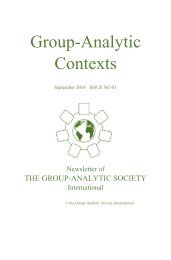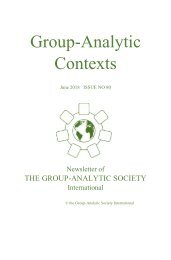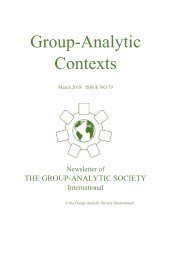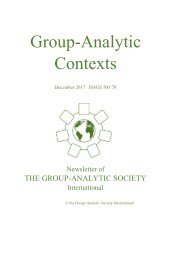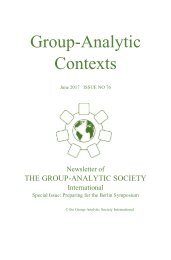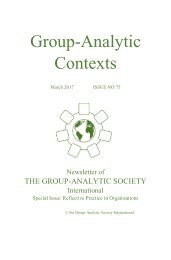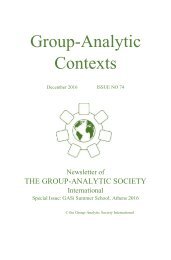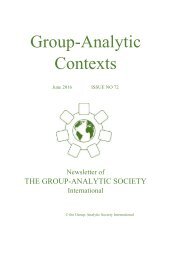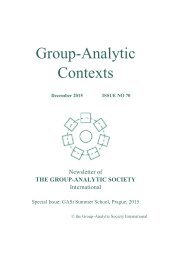Group Analytic Contexts, Issue 77, September 2017
Newsletter of the Group Analytic Society International
Newsletter of the Group Analytic Society International
You also want an ePaper? Increase the reach of your titles
YUMPU automatically turns print PDFs into web optimized ePapers that Google loves.
Newsletter – Autumn <strong>2017</strong> 107<br />
schizoid phase prepare for the depressive position, pseudo sociality<br />
becomes real. Triangle and circle touch at the point of highest<br />
containment for both, i.e. when the depressive position is reached.<br />
This means that access to and resolution of the Oedipus Complex<br />
afford the transcendence of the maternal circle (or absorption of the<br />
triangle by the circle). It is proposed that the triangle (psychoanalysis,<br />
father) and circle (GA, mother) co-exist in “benign symbiosis”.<br />
Koukis aims to introduce a new epistemological model of the<br />
symbolic roles of father and mother in the group. His ‘kaleidoscopic’<br />
model depicts their paternal and maternal functions within GA. It<br />
gives primacy to horizontal, interpersonal and transpersonal<br />
relationships, instead of focusing on vertical transferences. These<br />
interesting conceptualisations are the product of numerous articles and<br />
presentations he delivered over the years, as well as his creative<br />
interweaving of orthodox psychoanalysis and GA. Whilst his<br />
theoretical models are based on similar ontological and<br />
epistemological principles, he avoids psychoanalytic primacy - at least<br />
that is his aim.<br />
Throughout this “predetermined” book, Koukis discusses<br />
difficult and often neglected topics – money, envy, scapegoating,<br />
eating disorders, dreaming in psychosis, borderline presentations,<br />
depression in schizophrenia. Numerous helpful vignettes make his<br />
conceptualisations accessible. Using money (its role in payment for<br />
treatment) as an example, he describes 3 developmental phases of<br />
patients’ journey in group analytic therapy: their fusion with and<br />
separation from the group, and their individuation. He shows that envy<br />
can manifest as mild, intermediate and extreme in the group. Koukis<br />
then guides the reader through envy and its vicissitudes. He shows that<br />
the group always remains an object of envy due to introjection of dead<br />
mothering objects. Tracing the origins of envy back to the ‘alteration<br />
of the ego’, which is linked to the incorporation of the mothering and<br />
group analytic group as ‘dead’ objects, he holds that for patients with<br />
‘severe psychopathology’, dead objects can become even deader.<br />
Koukis demonstrates how envy can be transformed into jealousy in<br />
the group. In extreme cases of envy, group treatment might be counterindicated,<br />
because it can either result in premature termination of<br />
treatment or a severe attack on the group. A ‘good enough’ farewell<br />
can help, he assures the reader. Since early termination or drop out is<br />
concerning, group therapists may find his scenarios and explanations<br />
of how to avoid these (or if unavoidable, how to best address them)<br />
helpful.<br />
His chapter on scapegoating is equally informative.



